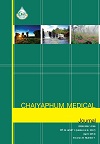Nursing Care for Patient with Upper Gastrointestinal Bleeding and Hypovolemic Shock and Acute Respiratory Failure: Case Study
Keywords:
upper gastrointestinal Bleeding, acute respiratory failure, nursingAbstract
The purpose of this study aims to study outcome nursing care for the patient with upper gastrointestinal bleeding and hypovolemic shock and acute respiratory failure in Chaiyaphum Hospital on May, 11th-17th 2013.
Thai male patient at 47 tear-old age had referral from lacal hospital with hematemesis, malea, anemia, weakness, gasping, hypothermia for proper management at Chaiyaphum Hospital. At Emergency room in Chaiyaphum Hospital, the doctor was ordered for complete blood count, blood for clotting time, electrolyte and result were HCT = 5.1 VOL%, WBC = 20.5 k/μL, RBC = 0.77 m/μL, platelet count = adequate, NE = 87.0%, LY = 10.0%, MO = 2.0%, EO = 1.0%, RBC morphology = abnormal, Microcyte = 1+, Hypochromia = 3+, PT = 16.7 sec, INR = 1.5, APTT = 24.7, PTT Ratio = 0.85, BUN = 69 mg/dl, Creatinine = 2.8 mg/dl, Sodium (Na) =142 mmol/L, Potassium (K) = 5.1 mmol/L, Chloride (CL) =116 mmol/L, Bicarbonate (CO2) = 11 mmol/L, and admitted at male medicine ward I, department of Medicine. Patients was received endotrachial tube with bird's respirator setting Assisted control, rate = 20/m, PIP = 12 cmHO2, PEEP = 5 cmHO2, FiO2 = 100%, retrained foleys catheter, on 0.9% NSS 2,000 ml free flow then 120 ml/hr, Gropping and matching for PRC 4 unit and FFP 2 unit. The doctor was treatment included losec 80 mg intravenous with stat dose then 40 mg for 12 hrs, kalimate 30 gms rectal suppository, ceftriazone 2 gms intravenous OD, octreotide 50 mg dilute drip intravenous, vitamin k 10 mg intravenous OD, NaCHO3 50 ml push intravenous, beradual 1 NB nebulizer for every 4 hours, clinda 600 mg intravenous for every 8 hours and colchicin (0.6) 1 tab oral tid pc, found 7 marks of nursing care problems: 1) Hypovolemic shock from blood loss in upper gastrointestinal 2) Inefficient breathing because decreased the exchange of gases 3) Imbalance of fluid and electrolyte from hematemesis, melea and notingper oral 4) The pituitary inefficient because viscous mucus and on enditrachial tube 5) Loss of verbal communications because lack of knowledge and skills for communication as on endotrachial tube. 6) Risk for phlebitis because patient received intravenous fluid and blood transfusion. 7) Patient and caregiver lack of knowledge on how to care for themselves. All the patients problems previous mentioned had been resolved resulted in doctor allowed patient to returning home and follow up two weeks. Patient had none of complication. To sum up, patient had been in hospital for 7 days, received caring recommendation while being at home. Patient and family understood and was able to perform state of caring correctly which lastly leaded to goal achievement.
References
วิทยา ศรีดามา. Clinical Practice guideline ทางอายุรกรรม 2542-2543. กรุงเทพฯ : จุฬาลงกรณ์มหาวิทยาลัย, 2542.
โรงพยาบาลชัยภูมิ. รายงานผลการดำเนินงานประจำปี 2556. ชัยภูมิ : ไทยเสรีการพิมพ์, 2556
วิพร เสนารักษ์. การวินิจฉัยการพยาบาล. พิมพ์ครั้งที่ 2 . ขอนแก่น : หจก.ขอนแก่นการพิมพ์, 2542.
เพ็ญจันทร์ สุวรรณแสง โมไนยพงศ์. การวิเคราะห์ผลการตรวจทางห้องปฏิบัติการสำหรับพยาบาล. กรุงเทพฯ : หจก.วี เจ พริ้นติ้ง, 2541.
ศิริรัตน์ เชาวรัตน์ และผ่องพรรณ อรุณแสง. การพยาบาลผู้ป่วยที่ใช้เครื่องช่วยหายใจ. อุบลราชธานี : โรงพิมพ์ผดุงสาร, 2535.
บุปผา ขันแข็ง. การดูแลผู้ป่วยเกี่ยวกับระบบทางเดินอาหาร. กรุงเทพฯ : หจก.ลดาวัลย์ พริ้นติ้ง, 2538.
สมจิต หนูเจริญกุล. แนวคิดทฤษฎีและการปฏิบัติการพยาบาล. กรุงเทพฯ : สหมิตร เมดิเพลส, 2537.
Downloads
Published
Issue
Section
License
Copyright (c) 2021 Chaiyaphum Medical Journal : ชัยภูมิเวชสาร

This work is licensed under a Creative Commons Attribution-NonCommercial-NoDerivatives 4.0 International License.





